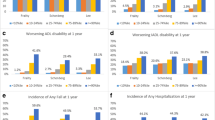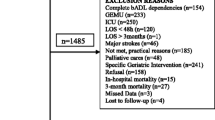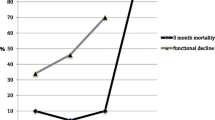Abstract
Objective: To prospectively develop and validate a predictive index to identify on admission elderly hospitalized medical patients at risk for functional decline.
Design: Two prospective cohort studies, in tandem. The predictive model developed in the initial cohort was subsequently validated in a separate cohort.
Setting: General medical wards of a university teaching hospital.
Patients: For the development cohort, 188 hospitalized general medical patients aged ≥70 years. For the validation cohort, 142 comparable patients.
Measurement and main results: The subjects and their nurses were interviewed twice weekly using standardized, validated instruments. Functional decline occurred among 51/188 (27%) patients in the development cohort. Four independent baseline risk factors (RFs) for functional decline were identified: decubitus ulcer (adjusted relative risk [RR] 2.7; 95% confidence interval [CI] 1.4, 5.2); cognitive impairment (RR 1.7; CI 0.9, 3.1); functional impairment (RR 1.8; CI 1.0, 3.3); and low social activity level (RR2.4; CI 1.2, 5.1). A risk-stratification system was developed by adding the numbers of RFs. Rates of functional decline for the low- (0 RF), intermediate- (1–2 RFs), and high- (3–4 RFs) risk groups were 8%, 28%, and 63%, respectively (p<0.0001).The corresponding rates in the validation cohort, of whom 34/142 (24%) developed functional decline, were 6%, 29%, and 83% (p<0.0001). The rates of death or nursing home placement, clinical outcomes associated with functional decline in the hospital, were 6%, 19%, and 41% (p<0.002) in the development cohort and 10%, 32%, and 67% (p<0.001) in the validation cohort, respectively, for the three risk groups.
Conclusions: Functional decline among hospitalized elderly patients is common, and a simple predictive model based on four risk factors can be used on admission to identify elderly persons at greatest risk.
Similar content being viewed by others

References
Glass RI, Mulvihill MN, Smith H, Peto R, Bucheister D, Stoll BJ. The 4 score: an index for predicting a patient’s non-medical hospital days. Am J Public Health. 1977;67:751–5.
Donaldson LJ, Jagger C. Outcome of admissions of elderly people to hospitals and homes: a survey and follow-up. Public Health. 1984;98:270–6.
Wachtel TJ, Derby C, Fulton JP. Predicting the outcome of hospitalization for elderly persons: home versus nursing home. South Med J. 1984;77:1283–5.
Wachtel TJ, Fulton JP, Goldfarb J. Early prediction of discharge disposition after hospitalization. Gerontologist. 1987;27:98–103.
Maguire PA, Taylor IC, Stout RW. Elderly patients in acute medical wards: factors predicting length of stay in hospital. BMJ. 1986;292:1251–3.
Narain P, Rubenstein LZ, Wieland GD, et al. Predictors of immediate and 6-month outcomes in hospitalized elderly patients: the importance of functional status. J Am Geriatr Soc. 1988;36:775–83.
Winograd CH, Gerety MB, Chung M, Goldstein MK, Dominguez F, Vallone R. Screening for frailty: criteria and predictors of outcomes. J Am Geriatr Soc. 1991;39:778–84.
Gillick MR, Serrell NA, Gillick IS. Adverse consequences of hospitalization in the elderly. Soc Sci Med. 1982;16:1033–8.
Warshaw GA, Moore JT, Friedman SW, et al. Functional disability in the hospitalized elderly. JAMA. 1982;248:847–50.
McVey LJ, Becker PM, Saltz CC, Feussner JR, Cohen HJ. Effect of a geriatric consultation team on functional status of elderly hospitalized patients: a randomized, controlled clinical trial. Ann Intern Med. 1989;110:79–84.
Hirsch CH, Sommers L, Olsen A, Mullen L, Winograd CH. The natural history of functional morbidity in hospitalized older patients. J Am Geriatr Soc. 1990;38:1296–303.
Steel K, Gertman PM, Crescenzi C, Anderson J. Iatrogenic illness on a general medical service at a university hospital. N Engl J Med. 1981;304:638–42.
Steel K. Iatrogenic disease on a medical service. J Am Geriatr Soc. 1984;32:445–9.
Katz S, Ford AB, Moskowitz RW, Jackson BA, Jaffe MW. Studies of illness in the aged: the index of ADL, a standardized measure of biological and psychosocial function. JAMA. 1963;185:914–9.
Lawton MP, Brady EM. Assessment of older people: self-maintaining instrumental activities of daily living. Gerontologist. 1969;9:179–86.
Folstein MF, Folstein SE, McHugh PR. The Folstein Mini-Mental State Examination: a practical method for grading the cognitive state of patients for the clinician. J Psychiatr Res. 1975;12:189–98.
Cornoni-Huntley J, Brock DB, Ostfeld AM, Taylor JO, Wallace RB (eds). Established populations for epidemiologic studies of the elderly: resource data book. NIH publication no. 86-2443. Bethesda, MD: National Institute on Aging, 1986;427.
Yesavage JA, Brink TL, Rose TL, et al. Development and validation of a geriatric depression screening scale: a preliminary report. J Psychiatr Res. 1983;17:37–49.
Sheikh JI, Yesavage JA. Geriatric Depression Scale (GDS): recent evidence and development of a shorter version. In: Brink TL (ed). Clinical Gerontology: A Guide to Assessment and Intervention. New York: Haworth Press, 1986; 165–73.
Seeman TE, Berkman LF. Structural characteristics of social networks and their relationship with social support in the elderly: who provides support. Soc Sci Med. 1988;26:737–49.
MacPhee GJA, Crowther JA, McAlpine CH. A simple screening test for hearing impairment in elderly patients. Age Ageing. 1988;17:347–51.
Inouye SK, van Dyck CH, Alessi CA, Balkin S, Siegal AP, Horwitz RI. Clarifying confusion: the Confusion Assessment Method; a new method for detection of delirium. Ann Intern Med. 1990;113:941–8.
Michocki RJ, Lamy PP. The problem of pressure sores in a nursing home population: statistical data. J Am Geriatr Soc. 1976;24:323–8.
Roberts BV, Goldstone LA. A survey of pressure sores in the over sixties on two orthopaedic wards. Int J Stud. 1979;16:355–64.
Charlson ME, Frederic LS, MacKenzie CR, Fields SD, Braham RL, Douglas RG. Assessing illness severity: does clinical judgment work? J Chron Dis. 1986;39:439–52.
Lazarus BA, Murphy JB, Coletta EM, McQuade WH, Culpepper L. The provision of physical activity to hospitalized elderly patients. Arch Intern Med. 1991;151:2452–6.
Applegate WB, Blass JP, Williams TF. Current concepts in geriatrics: instruments for the functional assessment of older patients. N Engl J Med. 1990;322:1207–14.
Elam JT, Graney MJ, Beaver T, El Derwi D, Applegate WB, Miller ST. Comparison of subjective ratings of function with observed functional ability of frail older persons. Am J Public Health. 1991;81:1127–30.
Rubenstein LZ, Schairer C, Wieland GD, Kane R. Systematic biases in functional status assessment of elderly adults: effects of different data sources. J Gerontology. 1984;39:686–91.
Charlson ME, Pompei P, Ales KL, MacKenzie CR. A new method of classifying prognostic comorbidity in longitudinal studies: development and validation. J Chron Dis. 1987;40:373–83.
Knaus WA, Draper EA, Wagner DP, Zimmerman JE. APACHE II: a severity of disease classification system. Crit Care Med. 1985;13:818–29.
Kleinbaum DG, Kupper LL, Morgenstern H. Epidemiologic Research: Principles and Quantitative Methods. New York: Van Nostrand Reinhold, 1982;351–63.
Feinstein AR. Clinical Epidemiology: The Architecture of Clinical Research. Philadelphia: W. B. Saunders, 1985; 177–86.
Kelsey JL, Thompson WD, Evans AS. Methods in Observational Epidemiology. Oxford: Oxford University Press, 1986; 285–97.
Cox DR. Regression models and life tables. J R Stat Soc. 1982;B34:187–220.
Mantel N, Haenszel W. Statistical aspects of the analysis of data from retrospective studies of disease. J Natl Cancer Inst. 1959;22:719–48.
Kaplan EL, Meier P. Non-parametic estimation from incomplete observations. J Am Stat Assoc. 1985;53:457–81.
Mantel N. Ranking procedures for arbitrarily restricted observations. Biometrics. 1967;23:65–78.
Feinstein AR. Clinimetrics. New Haven, CT: Yale University Press, 1987;194–5.
Gent M, Sackett DL. The qualification and disqualification of patients and events in long-term cardiovascular clinical trials. Thromb Haemost. 1979;41:123–34.
Berkman LF, Syme SL. Social networks, host resistance, and mortality: a nine-year follow-up study of Alameda County residents. Am J Epidemiol. 1970;109:186–204.
Henry JP. The relation of social to biological processes in disease. Soc Sci Med. 1982;16:369–80.
Arnetz BB, Theorell T, Levi L, Kallner A, Eneroth P. An experimental study of social isolation of elderly people: psychoendocrine and metabolic effects. Psychosom Med. 1983;45:395–406.
Eide R, Omvik P, Lund-Johansen P, Thyholdt R. The relationship of psychosocial factors to urinary catecholamines and arterial blood pressure in normal middle aged men in Western Norway. Scand J Behav Ther. 1984;13:3–24.
Gayton D, Wood-Dauphinee S, de Lorimer M, Tousignant P, Hanley J. Trial of a geriatric consultation team in an acute care hospital. J Am Geriatr Soc. 1987;35:726–36.
Fretwell MD, Raymond PM, McGarvey ST, et al. The senior care study: a controlled trial of a consultative/unit-based geriatric assessment program in acute care. J Am Geriatr Soc. 1990;38:1073–81.
Harris RD, Henschke PJ, Popplewell PY, et al. A randomized study of outcomes in a denned group of acutely ill elderly patients managed in a geriatric assessment unit or a general medical unit. Aust N Z J Med. 1991;21:230–4.
Rubenstein LZ, Josephson KR, Wieland GD, English PA, Sayre JA, Kane RL. Effectiveness of a geriatric evaluation unit: a randomized clinical trial. N Engl J Med. 1984;311:1664–70.
Hogan DB, Fox RA, Badley BWD, Mann OE. Effect of a geriatric consultation service on management of patients in an acute care hospital. Can Med Assoc J. 1987;136:713–7.
Applegate WB, Miller ST, Graney MJ, Elam JT, Burns R, Akins DE. A randomized controlled trial of a geriatric assessment unit in a community rehabilitation hospital. N Engl J Med. 1990;322:1572–8.
Author information
Authors and Affiliations
Additional information
Supported in part by grants from the John A. Hartford Foundation (Grant #88345-3G), the Robert Leete and Clara Guthrie Patterson Trust, the Retirement Research Foundation (Grants #90-44, 91-66), and the Sandoz Foundation for Gerontological Research (Grants #11, 27). Dr. Inouye is a Dana Foundation Faculty Scholar and recipient of Academic Award #lK08AB00524-01 from the National Institute on Aging.
Rights and permissions
About this article
Cite this article
Inouye, S.K., Wagner, D.R., Acampora, D. et al. A predictive index for functional decline in hospitalized elderly medical patients. J Gen Intern Med 8, 645–652 (1993). https://doi.org/10.1007/BF02598279
Issue Date:
DOI: https://doi.org/10.1007/BF02598279



